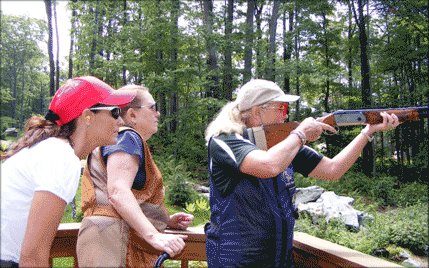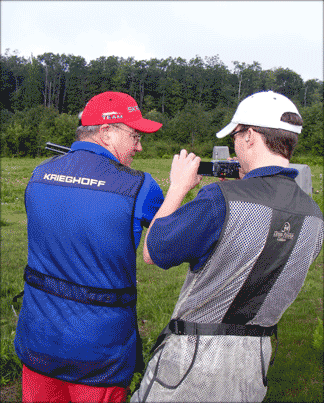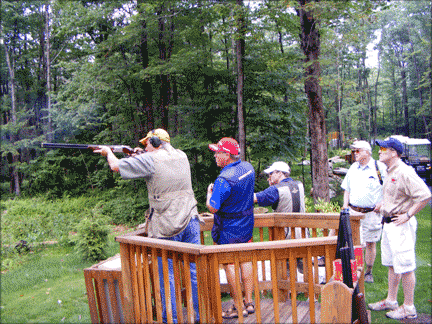9½ Hours With Gil & Vicki Ash
If you’ve ever watched Gil and Vicki Ash on their instructional DVDs, you walk away with the feeling that you really want to spend some time with these earnest Texans. They’re smart, funny and engaging. Well, what we discovered over a 9½ hour workshop with them is that they are exactly the same people in person as they are on your TV screen.
On August 13, 2009, Gil and Vicki hosted several writers at the new sporting clays courses of 7 Springs Mountain Resort, in Seven Springs, Pennsylvania, for a hands-on workshop concerning their unique approach to shooting clay targets.
In addition to myself, and Shotgun Life Editor, Deborah McKown, there were writers from magazines such as NRA’s American Hunter, Sports Afield and several well-respected freelancers who contribute to hunting publications. Most of them had been hunting all their lives and managed to turn their passion into a career. But I would venture to say that the Shotgun Life crew was the most avid sporting clays shooters in the group.

Gil and Vicki emphasize a commitment to a pre-shot plan that embraces strict attention to mount, focus and breakpoint. While many clays shooting instructors stress the mechanics of shooting, Gil and Vicki also believe that the mental part of the game is just as important. They help you manage the negative thoughts that can creep into your mind during the game and to eliminate any outburst even in the most frustrating moments of being on the station.
They also expect you to keep a log of your shooting outings. It calls for self-scoring of elements such as sleep the night before, meals you’ve eaten, general thoughts, distractions and other factors that give you greater insight into your shooting game.
While this soul-searching is always helpful, ultimately you do have to get out and shoot targets.
Long swing throughs with the gun mounted to your face are verboten because the gun is likely to obscure the target and cause you to miss. You only move your shotgun into the line of the target in the last 10 percent of target’s line – and you come at it from underneath to avoid blocking your view of it.
The fact that they identify the face, rather than the shoulder, as the anchor point for your shotgun underscores their steadfastness to a method where you don’t pull the trigger until the very moment the gun does touch your face.
All that stuff about leads, and being in front of the target or behind is, at the end of the day, a bunch of hogwash. From their perspective, in order to break the target the gun has to be at the established breakpoint prior to the target being there. If this sounds like a case of semantics, it’s really not, because all too often lead is associated with swing versus inserting the gun into the line of the target, as they instruct. During the clinic, I always referred to lead as the “L word.”
Perhaps most important is how you recover from a missed target. When you miss, stay in the gun and play the shot over in your head and then ask yourself “Why – why did I miss that target?” In essence, there is no such thing as a wasted shot.
In conversations with Gil and Vicki, they’ll be the first to admit that they often find themselves outside the pale of experts often cited in clays shooting circles. Still, they have amassed a large and loyal following of students dedicated to their books and DVDs in an ongoing effort to perfect the OSP method of shooting.
Our session with Gil and Vicki started at 8:00 AM in the stunning clubhouse of the new Seven Springs sporting clays facility. Over coffee and Danish, Gil gave us a whiteboard presentation that was almost an anatomy lesson of the eye. Gil and Vicki’s unwavering belief in 100-percent visual focus on the target has sent them on a mission to understand exactly how the eye works and how that knowledge can be applied to the shotgun sports.
About 30 minutes later, we were out on the course. The writers divided up into two groups, and we went with Vicki.

Naturally, it would be impossible to capture every nuance of a 9½ hour workshop with them, so what follows are some of the most important tips we picked up moving from station to station:
- You’ll never shoot better than the quality of our move and mount.
- As soon as you see the target you start to move with it. That’s how you get in synch with the target.
- Every time I look at the target breakpoint, I visualize the target breaking.
- Ask yourself these three questions when you miss:
- Did I see the front of the bird?
- Was I in synch with the bird?
- Did the gun touch my face when I pulled the trigger?
- You have to maintain a connection with your nose and the target. That’s how you maintain focus on the target.
In refining some of these core principles, and others, each member of our squad took a turn at the different stations shooting at relatively easy presentations. The point here was to unlearn bad habits and take baby steps into the OSP method.
Given the time and logistics we mostly focused on the mechanics of their method, which for most targets almost comes to a point-and-shoot rather than a long swing that starts near the trap. The idea of “inserting the gun” in the line of the target compared with swinging the gun makes an enormous amount of sense when you consider that Gil and Vicki have simplified the world clays shooting into two target types: quartering and crossers.
Their “insertion” approach also virtually eliminates the mental calculations of determining lead as you attempt to break the target. For example, a rule of thumb for clays shooting is that you never look at the barrel; once you do, your eye has moved off the target. But in reality, if you’re trying to determine the lead on a particular shot it’s really quite easy for your eyes to bounce between barrel and bird even at the subconscious level.

By contrast, if you insert your gun into the line of the target at your pre-established break point, your lead is virtually eliminated – allowing you to completely focus on the target.
At the workshop, the relatively easy targets that were thrown gave us the opportunity to learn the insertion method. The course had been set for slow targets, which let you develop the integrated move and mount so that you could coordinate gun-to-face and trigger pull within the last 10% of the line prior to your breakpoint.
Naturally, the group dynamics of a workshop don’t allow them to emphasize all the mental aspects of their OSP method. In short, though, it came down to a relaxed approach to shooting. You entered the station and createred a “trigger,” which was something that would begin your preshot mental routine. It would talk yourself down from nervous, negative chatter, visualize crushing the target at the breakpoint and when you were completely in control of the situation you would call for the target.
As the workshop drew to a close, you could see some of the veteran hunting writers in a state of shock that clays could be so straightforward.
Irwin Greenstein is the publisher of Shotgun Life. You can reach him at letters@shotgunlife.com.
Useful resources:
{loadposition signup}

Irwin Greenstein is Publisher of Shotgun Life. Please send your comments to letters@shotgunlife.com.


Comments